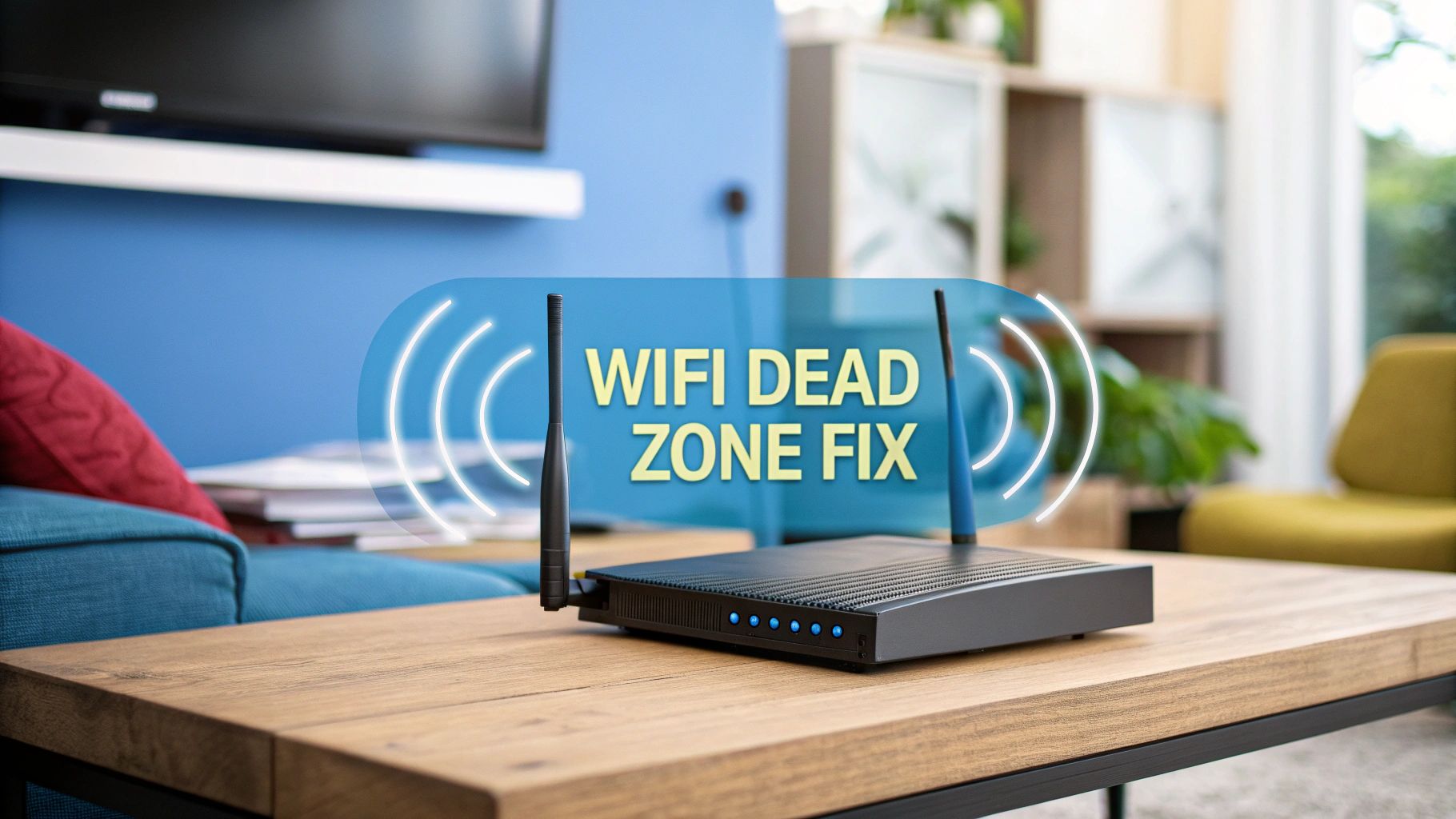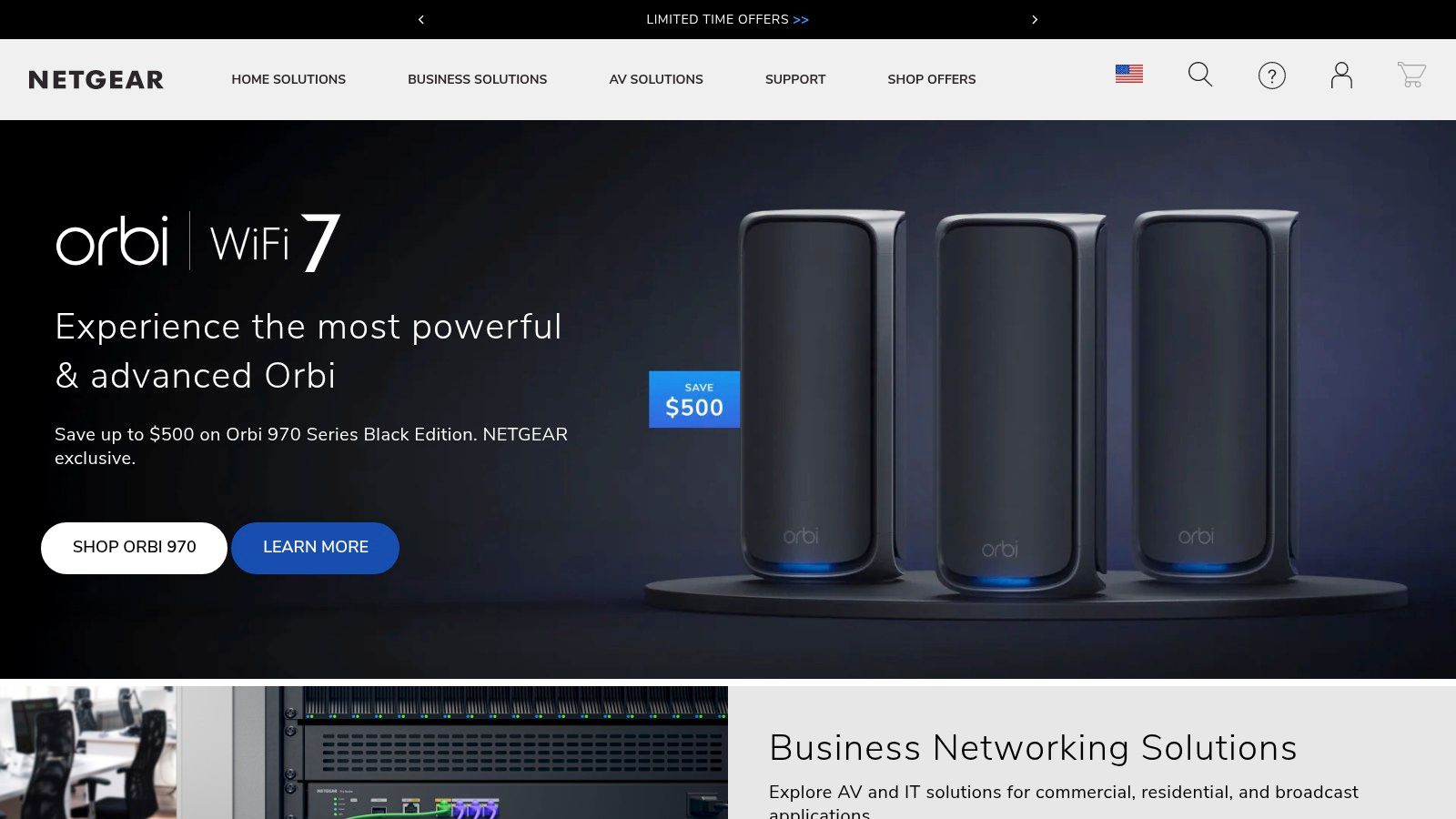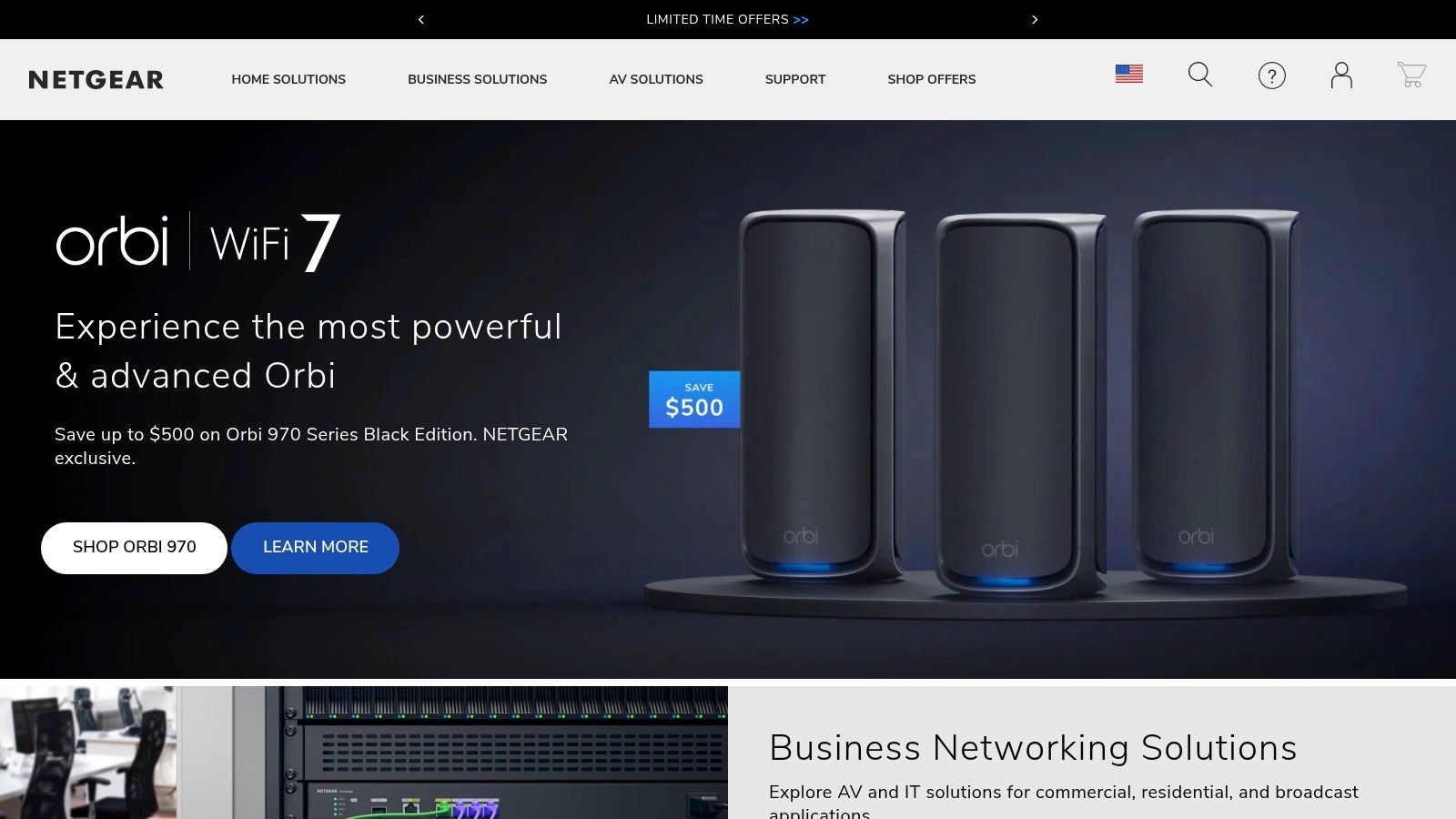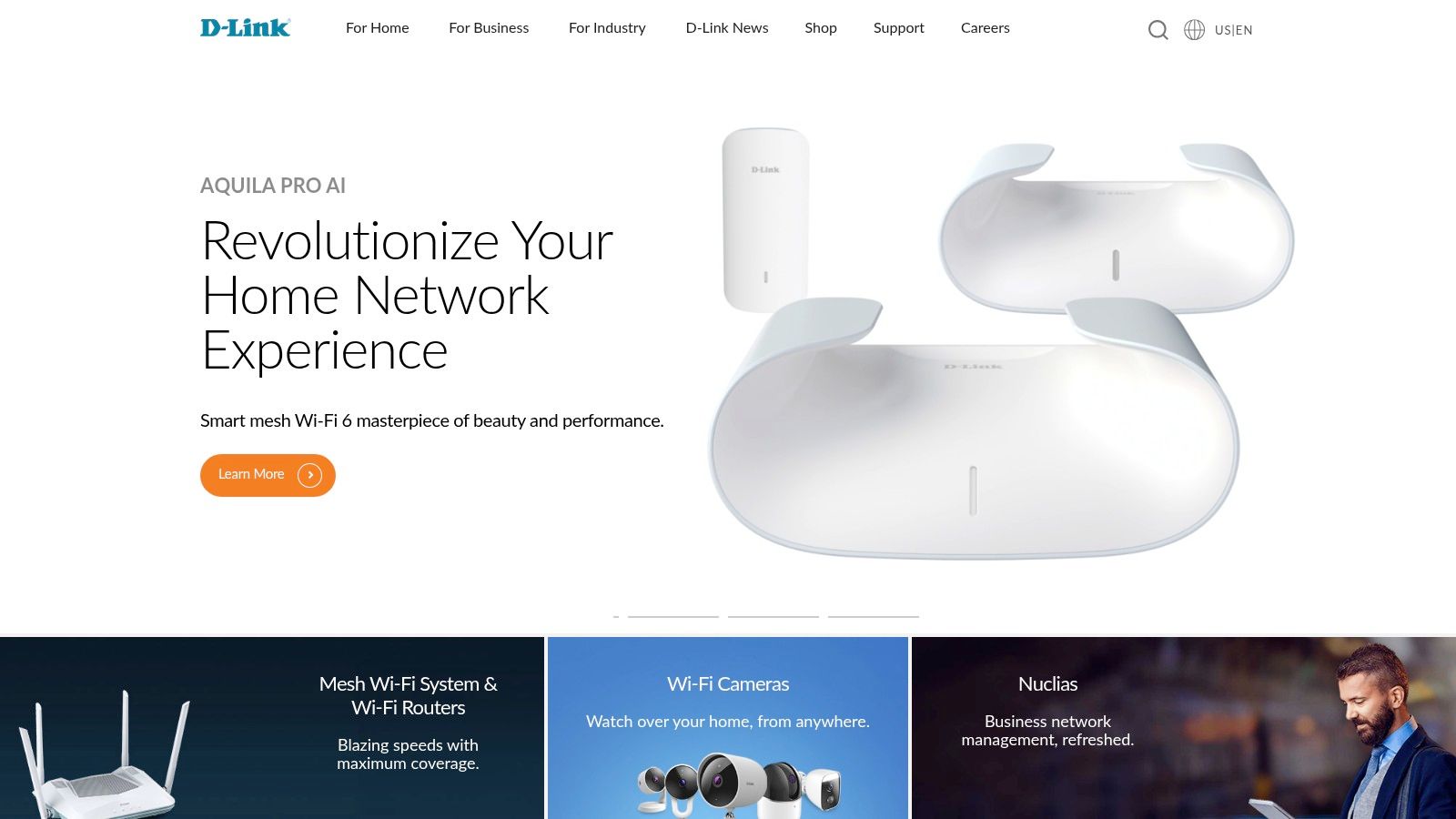

· Por James
Top WiFi Dead Zone Solutions for Better Connectivity
Understanding WiFi Dead Zones and Their Causes
Frustrated with WiFi dead zones disrupting your work or streaming? This listicle presents eight powerful wifi dead zone solutions to boost your connectivity. Whether you're an RV traveler, remote worker, or simply live in a rural area with spotty internet, these tools can eliminate weak signals and extend your WiFi range. Learn about top-rated mesh systems and extenders, including the NETGEAR Nighthawk, TP-Link RE650, and Google Nest Wifi Pro, to banish buffering and enjoy seamless online access.
1. NETGEAR Nighthawk AX8 EAX80 WiFi 6 Mesh Extender
Suffering from frustrating WiFi dead zones in your RV, rural home, or even while traveling and working remotely? Eliminating these connectivity black holes can dramatically improve your online experience. One powerful solution for banishing weak signals and maximizing your internet performance is the NETGEAR Nighthawk AX8 EAX80 WiFi 6 Mesh Extender. This premium device leverages the latest WiFi 6 technology to deliver blazing-fast speeds and blanket your space with a reliable connection, making it a top contender for anyone struggling with inconsistent internet access.

The Nighthawk AX8 EAX80 distinguishes itself through its robust feature set, specifically designed to tackle the challenges of modern internet usage. Its WiFi 6 (802.11ax) technology offers speeds up to a staggering 6Gbps, far exceeding the capabilities of older WiFi standards. This translates to smoother streaming, faster downloads, and lag-free online gaming, even when multiple devices are connected. Its dual-band coverage extends up to 2,500 sq ft, making it a viable option for larger RVs, multi-story homes, or even extending coverage to outdoor areas around your campsite. For those working remotely or traveling in an RV with multiple family members online, the 4x4 MU-MIMO technology ensures that each connected device receives optimal bandwidth, preventing bottlenecks and ensuring everyone enjoys a seamless online experience.
One of the key features for RV travelers and those moving between locations is the seamless roaming capability. The Nighthawk AX8 EAX80’s Smart Roaming intelligently switches your devices to the strongest WiFi signal as you move throughout your space. This ensures uninterrupted connectivity as you wander through your RV or relocate to a different work area in your rural home. No more manually connecting to different networks or experiencing sudden drops in connectivity during video calls.
Setting up the Nighthawk AX8 EAX80 is surprisingly straightforward. It's designed to work with any existing router, eliminating the need for complex configurations. You can quickly extend your network using the simple WPS button or through a user-friendly web interface. This plug-and-play functionality makes it ideal for even the least tech-savvy users. Additionally, the inclusion of a Gigabit Ethernet port allows you to connect wired devices directly to the extender, providing a reliable connection for devices like gaming consoles or smart TVs.
While the Nighthawk AX8 EAX80 offers exceptional performance and features, it's important to consider its potential drawbacks. Its premium price point reflects its cutting-edge technology, meaning it's a more significant investment compared to older WiFi extenders. Its relatively large physical footprint might also be a consideration for those with limited space. Furthermore, if your internet plan has a lower speed tier, the full potential of the AX8’s 6Gbps capability might not be fully utilized. However, this future-proofs your network, ensuring you're prepared for faster internet speeds as they become available.
Despite these minor drawbacks, the NETGEAR Nighthawk AX8 EAX80 remains an excellent wifi dead zone solution. Its powerful performance, ease of use, and future-proof technology make it a valuable investment for those seeking reliable and high-speed internet access, whether in an RV, a rural home, or on the go. It's especially beneficial for remote workers and travelers who rely on consistent connectivity for their work and leisure activities. You can find more information and purchase the Nighthawk AX8 EAX80 on the NETGEAR website.
2. TP-Link RE650 AC2600 WiFi Range Extender
Suffering from WiFi dead zones in your RV, rural home, or even just a sprawling suburban house? Finding a reliable WiFi dead zone solution can feel like searching for the proverbial needle in a haystack. The TP-Link RE650 AC2600 WiFi Range Extender offers a powerful and practical solution, bringing robust connectivity to previously unreachable corners of your space. This extender excels at bridging the gap between your router and devices struggling to connect, making it a valuable tool for RV travelers, remote workers, and anyone battling inconsistent internet access. Its impressive range and speed make it a strong contender for those seeking a reliable fix for WiFi woes.

The TP-Link RE650 boasts AC2600 dual-band speeds, delivering up to 800Mbps on the 2.4GHz band and a blazing 1733Mbps on the 5GHz band. This combined throughput of up to 2.6Gbps makes it ideal for bandwidth-heavy activities like streaming HD video, online gaming, and video conferencing, even in areas previously plagued by weak signal. Imagine enjoying uninterrupted Zoom calls from your RV parked in a remote campsite, or streaming your favorite shows without buffering, even in the furthest bedroom of your rural home. This performance makes the RE650 a particularly attractive wifi dead zone solution.
For RV travelers, the RE650 offers a significant advantage. Campground WiFi can be notoriously unreliable, often leaving you with a weak signal only accessible near the campground office. The RE650 extends the reach of this signal, allowing you to enjoy strong connectivity throughout your RV. Similarly, for those living in rural areas without fiber optic internet, relying on DSL or satellite internet often means contending with limited range. This extender helps distribute that signal more effectively, eliminating dead spots and providing a more consistent online experience.
Setting up the RE650 is remarkably straightforward, even for non-techies. The TP-Link Tether app guides you through the process step-by-step, making it easy to connect the extender to your existing router and optimize its placement. The intelligent signal indicator helps you find the ideal spot to maximize coverage, eliminating the guesswork and ensuring optimal performance. The RE650's four external adjustable antennas further contribute to its impressive range, covering up to 14,000 square feet. This means fewer dead zones and more consistent connectivity throughout your home, RV, or workspace.
Beyond extending your existing WiFi, the RE650 offers an Access Point mode. This functionality allows you to create a new WiFi network using a wired internet connection. This feature is particularly beneficial for RV travelers who may need to connect to campground ethernet for a more stable connection. Simply connect the RE650 to the ethernet port, and you have a private, high-speed WiFi network within your RV.
While the TP-Link RE650 offers a robust solution for eliminating WiFi dead zones, it does have a few minor drawbacks. The device is somewhat bulky due to its external antennas, which might be a consideration for those with limited space. Additionally, occasional firmware updates are required, but these are generally quick and easy to install through the Tether app. Finally, optimal performance hinges on finding the perfect placement for the extender, so some experimentation might be necessary.
Priced competitively (typically ranging from $70-$100 USD), the TP-Link RE650 provides excellent value for its performance. The combination of powerful dual-band speeds, impressive range, easy setup, and versatile functionality makes it a standout choice for anyone searching for effective WiFi dead zone solutions. For remote workers, RV travelers, or those living in rural areas, the TP-Link RE650 can significantly improve online connectivity and productivity, making it a worthwhile investment for a more seamless online experience. You can find more information and purchase the RE650 on the TP-Link website: https://www.tp-link.com
3. ASUS AiMesh AX6100 WiFi System (RT-AX92U)
Eliminating wifi dead zones in your RV, rural home, or even a sprawling suburban house can be a frustrating endeavor. Simple range extenders often fall short, creating unstable connections and frustrating lag. If you're seeking a robust solution for seamless whole-home coverage, the ASUS AiMesh AX6100 WiFi System (RT-AX92U) deserves serious consideration. This powerful tri-band WiFi 6 mesh system is designed to blanket your space with a reliable, high-speed signal, making it a top contender among wifi dead zone solutions. It’s particularly well-suited for those who rely heavily on internet connectivity, like RV travelers, remote workers, and those living in areas with limited internet options.

The ASUS AiMesh AX6100 distinguishes itself from basic extenders through its dedicated 5GHz backhaul. This dedicated channel for communication between the router units ensures that your internet speed doesn’t suffer as the signal is extended throughout your space. Imagine streaming a movie in your RV’s bedroom while your partner works on a video conference in the living area – with the AiMesh AX6100, both activities can occur simultaneously without buffering or interruptions. This system excels in environments where multiple devices are constantly competing for bandwidth, making it ideal for families or shared workspaces. It boasts coverage up to 5,500 sq ft with the 2-pack system, and you can expand this even further by adding compatible ASUS routers to the mesh network. This scalability is a significant advantage for larger homes, RVs, or even properties with outbuildings where you need consistent connectivity.
Beyond its performance, the AiMesh AX6100 shines in terms of security and user management. AiProtection Pro, powered by Trend Micro, provides commercial-grade security features, protecting your network and connected devices from online threats. This is crucial, especially for remote workers handling sensitive data or families concerned about online safety. The adaptive QoS (Quality of Service) allows you to prioritize traffic, ensuring that critical applications like video conferencing or online gaming receive the bandwidth they need, even during peak usage. Advanced parental controls also give you granular control over internet access for different users and devices.
For those constantly on the move, such as RV travelers, the system’s portability and ease of setup are significant advantages. While the initial setup requires the ASUS app, the interface is generally user-friendly, guiding you through the process step by step. Once configured, the system seamlessly manages network traffic, allowing you to focus on work or leisure without constant troubleshooting. While the price point is higher than basic range extenders, the superior performance, robust security, and advanced features justify the investment, especially for those who rely heavily on a consistent and secure internet connection.
However, be aware that the AiMesh AX6100’s comprehensive feature set may feel overwhelming for users who prefer a simpler “plug-and-play” solution. The reliance on the ASUS app for full functionality may also be a drawback for some. Pricing can vary, so it's recommended to check current retail prices. If you're looking for a detailed guide to mapping your WiFi coverage for optimal performance, you may find this helpful: Learn more about ASUS AiMesh AX6100 WiFi System (RT-AX92U).
In summary, the ASUS AiMesh AX6100 offers a powerful solution for banishing wifi dead zones. Its tri-band WiFi 6 technology, dedicated backhaul, and robust security features provide a significant upgrade over traditional extenders, making it an excellent choice for anyone needing reliable, high-speed internet access throughout their space, whether it's a sprawling home, a remote cabin, or an RV on the open road. While the system’s complexity and price may be a consideration, the benefits of a seamless, secure, and high-performing network make it a worthwhile investment for those seeking the best in wifi dead zone solutions. Visit the ASUS website for more information.
4. Linksys RE7000 Max-Stream AC1900+ WiFi Range Extender
Eliminating WiFi dead zones can be a significant challenge, especially for those living in larger homes, RVs, or rural areas with limited internet access. The Linksys RE7000 Max-Stream AC1900+ WiFi Range Extender offers a practical and affordable solution for extending your existing WiFi network and banishing those frustrating connectivity gaps. This dual-band extender is designed to boost your signal and provide reliable coverage for a variety of online activities, from streaming movies and video conferencing to online gaming and remote work. It's a particularly attractive wifi dead zone solution for RV travelers, RV owners, and those working remotely from rural locations who need a consistent and robust internet connection.

The Linksys RE7000 leverages MU-MIMO (Multi-User, Multiple-Input, Multiple-Output) technology, allowing it to handle multiple devices simultaneously without significant performance degradation. This is crucial for households or RV travelers with multiple connected devices like smartphones, laptops, and smart TVs. Imagine streaming a movie on your smart TV while your partner participates in a video conference, all without experiencing buffering or lag. This smooth, simultaneous operation is made possible by the RE7000's MU-MIMO capabilities. Further enhancing performance is Cross-Band technology, which maximizes data flow by sending and receiving data on different WiFi bands concurrently. This is especially beneficial for bandwidth-intensive activities like online gaming or large file downloads.
One of the standout features of the RE7000 is its Spot Finder Technology. This feature simplifies the setup process by guiding you to the optimal placement for the extender. Finding the sweet spot for a range extender can often be a trial-and-error process, but the Spot Finder Technology takes the guesswork out of it, ensuring you get the best possible performance from the device. For RV owners, this feature is particularly helpful as it allows for quick and easy setup at each new campsite. Furthermore, the compact wall-plug design makes it unobtrusive and easy to integrate into any environment, whether it's a small apartment, a spacious RV, or a rural cabin.
The RE7000 boasts AC1900+ dual-band speeds and extends WiFi coverage up to 10,000 square feet, making it a viable wifi dead zone solution for larger properties or even extending coverage to outdoor areas. It also includes a Gigabit Ethernet port, allowing you to connect wired devices like gaming consoles or desktop computers directly to the extender for a faster and more stable connection. This versatility makes the RE7000 a comprehensive solution for all your connectivity needs. While the RE7000 generally performs well, it's important to note that optimal performance hinges on correct placement. Experimentation might still be necessary to find the perfect spot in your specific environment. Additionally, while setup is generally easy, the RE7000 offers limited advanced configuration options compared to some higher-end extenders. Some users have also reported occasional connection drops, though this seems to be infrequent.
The Linksys RE7000 Max-Stream AC1900+ WiFi Range Extender typically retails for around $80-$100, offering a good balance of features and affordability. It's compatible with any WiFi router, including the latest WiFi 6 routers, ensuring future-proof connectivity. For those seeking a reliable and cost-effective solution to eliminate wifi dead zones, the RE7000 is definitely worth considering. You can find more information and purchase the extender on the official Linksys website: https://www.linksys.com. Setting up the extender is straightforward, usually involving a simple web-based interface or the Linksys app. Follow the included instructions or visit the Linksys website for detailed setup guides. Consider using a WiFi analyzer app to identify the signal strength throughout your space both before and after installing the extender to ensure optimal coverage.
5. Amazon eero Pro 6E Mesh WiFi System
Eliminating WiFi dead zones in your RV, rural home, or even a sprawling suburban house can feel like an endless battle. Spotty connections disrupt video calls, streaming sessions stall, and smart home devices become frustratingly unreliable. If you're tired of searching for a signal, the Amazon eero Pro 6E Mesh WiFi System might be the wifi dead zone solution you've been looking for. This powerful mesh system leverages the latest WiFi 6E technology to blanket your space with reliable, high-speed internet access, making it an ideal solution for anyone from RV travelers working remotely to families in rural areas struggling with limited connectivity options.

The eero Pro 6E system distinguishes itself through its use of tri-band WiFi 6E. Unlike traditional routers and even many mesh systems that utilize the congested 2.4GHz and 5GHz bands, the eero Pro 6E taps into the newly opened 6GHz band. This provides a much wider, cleaner channel for data transmission, dramatically reducing interference and latency. Imagine streaming a 4K movie in your RV while parked next to several other families also using WiFi – with 6GHz, you’re far less likely to experience buffering or dropped connections. This same principle applies to rural homes where neighbors' WiFi signals might otherwise overlap and cause interference. The system boasts coverage of up to 2,000 square feet per unit, meaning a 3-pack can effectively cover a large RV, a multi-story home, or even a small property. For larger spaces, additional units can be added seamlessly to expand coverage.
The eero Pro 6E isn’t just about speed and coverage; it also simplifies network management. Setup is remarkably straightforward, usually involving little more than plugging in the eero units and following the instructions in the user-friendly eero app. This app also allows you to manage your network remotely, prioritize devices, and even set up guest networks. Furthermore, the eero Pro 6E acts as a built-in Zigbee smart home hub, allowing you to connect and control compatible smart devices directly through the eero system. This simplifies smart home integration, especially valuable in RVs where space and complexity are often constraints. For those concerned about security, the eero Secure subscription provides advanced online security features, including malware protection and ad blocking, providing peace of mind for remote workers handling sensitive data.
While the eero Pro 6E system offers a compelling wifi dead zone solution, it's crucial to consider its limitations. The advanced security features mentioned above require an eero Secure subscription, adding to the overall cost. Furthermore, while the simplified setup and management are beneficial for most users, those who prefer granular control over their network settings might find the limited manual configuration options restrictive. Finally, unlocking the full potential of the system, including the advanced security features, necessitates a higher cost of entry compared to other mesh systems lacking 6E technology.
The price for the eero Pro 6E system varies depending on the number of units. A single unit typically retails for around $299, while a 3-pack can be found for around $699. While this represents a higher initial investment than some other options, the performance and features justify the price for those seeking a truly robust and future-proof wifi dead zone solution.
For users prioritizing cutting-edge technology, seamless integration within the Amazon ecosystem, and simplified network management, the eero Pro 6E is a compelling option. It’s particularly well-suited for RV travelers, remote workers, and those living in rural areas where reliable, high-speed internet is essential. You can find more information and purchase the eero Pro 6E Mesh WiFi System directly from the eero website: https://eero.com. With its powerful hardware, user-friendly software, and expansion capabilities, the eero Pro 6E provides a compelling answer for those struggling with persistent wifi dead zones.
6. NETGEAR Orbi RBK50 AC3000 Tri-Band Mesh System
Dealing with WiFi dead zones can be incredibly frustrating, especially for those who rely on a consistent connection for work, entertainment, or staying connected while traveling. Whether you're working remotely from your RV, struggling with spotty internet in a rural home, or just tired of buffering in certain areas of your house, a mesh WiFi system can be a game-changer. The NETGEAR Orbi RBK50 AC3000 Tri-Band Mesh System stands out as a powerful solution for eliminating these frustrating dead zones and providing a seamless online experience. This system utilizes advanced technology to blanket your space with reliable WiFi, making it an excellent choice for anyone seeking a robust and comprehensive wifi dead zone solution. For those living in rural areas or traveling in RVs, where reliable internet access can be challenging, the Orbi RBK50 can be a particularly valuable tool.

What sets the Orbi RBK50 apart is its dedicated 5GHz backhaul. Unlike dual-band mesh systems that share bandwidth between devices and the backhaul connection between the router and satellite units, the Orbi RBK50 dedicates an entire 5GHz band for communication between the router and satellite. This ensures maximum speeds for connected devices, even when multiple devices are streaming, gaming, or participating in video conferences. This is particularly beneficial for households with numerous smart home devices, which can quickly bog down a less powerful network. The Orbi RBK50 supports speeds up to 3Gbps, making it more than capable of handling the demands of modern online activities, from 4K streaming to online gaming. For RV travelers and those in rural locations, this translates to a reliable and fast connection, even when traditional internet options are limited.
Covering up to 5,000 square feet with the included router and satellite, the Orbi RBK50 is well-suited for larger homes, RVs, and properties with outbuildings. Its tri-band technology, combined with 4x4 MU-MIMO, allows multiple devices to connect simultaneously without sacrificing performance. Imagine streaming a movie in the RV while others work online, all without experiencing lag or buffering. This robust performance makes it an ideal wifi dead zone solution for families and those who work remotely. Six Gigabit Ethernet ports (four on the router and two on the satellite) offer wired connectivity for devices like game consoles and desktop computers that benefit from a wired connection.
Setting up the Orbi RBK50 is remarkably simple, even for those less tech-savvy. The Orbi app guides you through the process, making it easy to configure the network and manage settings. The system also includes Circle Smart Parental Controls, allowing you to manage screen time, filter content, and ensure a safe online environment for children. This is a valuable feature for families traveling in RVs or living in rural areas where alternative internet safety solutions might be limited.
While the Orbi RBK50 offers significant advantages, it's important to be aware of its drawbacks. The units are larger than some competing mesh systems, which might be a consideration for those with limited space. It also comes at a premium price point compared to other mesh WiFi solutions. Finally, while the AC3000 standard still offers excellent performance, it doesn't offer the latest WiFi 6 future-proofing. However, for users prioritizing immediate, reliable coverage and speed, the Orbi RBK50 remains a powerful choice. You can Learn more about NETGEAR Orbi RBK50 AC3000 Tri-Band Mesh System for a more detailed understanding of how this device can address signal boosting for cellular devices.
For those in rural areas or frequently on the move in an RV, finding reliable wifi dead zone solutions can be crucial. The NETGEAR Orbi RBK50 provides a comprehensive answer with its robust performance, wide coverage, and ease of use. It’s an investment in seamless connectivity, making it a valuable asset for anyone who demands consistent, high-speed internet access, no matter their location.
7. D-Link DAP-1650 AC1200 WiFi Range Extender
Eliminating WiFi dead zones can be a significant challenge, especially for those living in larger homes, RVs, or rural areas with limited internet access. For those seeking a budget-friendly wifi dead zone solution, the D-Link DAP-1650 AC1200 WiFi Range Extender offers a practical way to boost your existing WiFi signal and extend coverage to previously unreachable areas. This makes it a valuable tool for RV travelers, remote workers, and anyone struggling with spotty internet in their homes. This range extender aims to provide reliable connectivity without breaking the bank, making it an attractive option for basic WiFi expansion needs.

The D-Link DAP-1650 operates on dual-band AC1200 technology, offering speeds of up to 300Mbps on the 2.4GHz band and 867Mbps on the 5GHz band. While these speeds aren't the fastest available compared to newer WiFi 6 standards, they are sufficient for everyday tasks like browsing, streaming standard-definition video, and online work. For RV travelers relying on campground WiFi or mobile hotspots, this extender can significantly improve signal strength inside the RV, allowing for more stable connections. Similarly, those living in rural areas with limited internet options can use the DAP-1650 to distribute a weak signal more effectively throughout their homes.
This range extender features four external 5dBi antennas, which contribute to its enhanced coverage capabilities. These antennas help direct the WiFi signal more efficiently, penetrating walls and other obstacles to reach those stubborn dead zones. This is particularly beneficial in larger RVs or homes with multiple rooms and levels. The included Smart Signal Indicator simplifies the setup process. By observing the indicator lights, users can easily identify the optimal placement for the extender to achieve the strongest possible signal.
The D-Link DAP-1650 offers both Range Extender and Access Point modes, providing flexibility for different deployment scenarios. In Range Extender mode, it amplifies your existing router’s signal. In Access Point mode, it can be connected to a wired network to create a new WiFi hotspot. This versatility makes it a useful tool for various applications. For instance, remote workers in rural areas could utilize the Access Point mode to create a dedicated workspace WiFi network from a wired internet connection. Similarly, RV travelers can use this mode to create a private network within their RV, sharing a single internet connection amongst multiple devices.
Setting up the D-Link DAP-1650 is designed to be user-friendly, even for those with limited technical experience. The WPS (Wi-Fi Protected Setup) button allows for quick and easy connection to your existing router with a simple push of a button. Alternatively, you can use the web-based interface for a more detailed configuration.
While the D-Link DAP-1650 provides a cost-effective wifi dead zone solution for basic needs, it’s essential to be aware of its limitations. Its AC1200 speeds might be insufficient for demanding tasks like 4K streaming or online gaming, especially with multiple devices connected simultaneously. Additionally, its feature set is relatively basic compared to more advanced extenders on the market. If you anticipate heavy network usage with numerous devices or require advanced features like MU-MIMO, you may need to consider a higher-end model. However, for users prioritizing affordability and straightforward setup for extending WiFi coverage to address dead zones in smaller to medium-sized environments, particularly for uses such as RVing or remote work in areas with less-than-ideal internet infrastructure, the D-Link DAP-1650 provides a viable solution. You can find more information and potentially purchase the extender on the D-Link website: https://www.dlink.com
8. Google Nest Wifi Pro 6E Mesh System
Eliminating Wi-Fi dead zones, especially in larger spaces or areas with unique construction, can be a significant challenge. Whether you're battling thick walls in a rural home, seeking reliable connectivity in a sprawling RV, or simply trying to ensure seamless coverage across a multi-story house, a mesh Wi-Fi system often provides the best solution. The Google Nest Wifi Pro 6E is a compelling option in this category, offering a compelling blend of performance, ease of use, and sleek design that makes it an excellent choice for addressing those frustrating connectivity gaps. This system leverages the latest Wi-Fi 6E technology to provide fast, reliable coverage throughout your home, RV, or even temporary workspace while on the road.

Each Google Nest Wifi Pro 6E unit covers up to 2,200 square feet, making it suitable for a wide range of living spaces and even larger RVs. For those living in rural areas or traveling in their RVs, extending the network to outdoor spaces becomes crucial for maintaining connectivity. The mesh system allows you to add additional units seamlessly, creating a blanket of Wi-Fi that reaches every corner of your property or campsite. This is especially important for remote workers who rely on a strong internet connection for video conferences, file transfers, and general online work tasks. Imagine working from your RV parked by a scenic lake, enjoying uninterrupted connectivity thanks to the Google Nest Wifi Pro 6E.
Setting up and managing the system is a breeze with the Google Home app. This intuitive app simplifies the process, eliminating the need for complex configurations. Even for those less tech-savvy, setting up the mesh network is straightforward. The app also provides a centralized control point for managing your network, allowing you to prioritize devices, check network speeds, and set up guest networks. This simple management makes the Google Nest Wifi Pro 6E a particularly appealing wifi dead zone solution for those constantly on the move, like RV travelers and remote workers, as they can quickly adapt their network to new locations.
One of the key advantages of the Google Nest Wifi Pro 6E is its utilization of the 6GHz band, a feature exclusive to Wi-Fi 6E. This dedicated band significantly reduces congestion, resulting in faster speeds and improved performance, especially in environments with many connected devices. For digital nomads or families traveling in RVs, this is a game-changer. Multiple devices – laptops, smartphones, streaming devices – can connect simultaneously without impacting network performance. Learn more about Google Nest Wifi Pro 6E Mesh System. Further enhancing its appeal for security-conscious users, the system includes automatic security updates and threat detection, ensuring your network remains protected from evolving cyber threats.
While the Google Nest Wifi Pro 6E shines in its simplicity and performance, it does have a few limitations. Advanced users might find the configuration options somewhat restricted compared to other mesh systems. The number of Ethernet ports per unit is also limited, potentially requiring a separate switch for users with multiple wired devices. Finally, full functionality requires a Google account, which might not be ideal for everyone.
Pricing for the Google Nest Wifi Pro 6E varies depending on the number of units purchased. A single router typically costs around $200, while multi-packs offer a more cost-effective solution for covering larger areas. Technical requirements are minimal, primarily requiring a modem and an internet connection. Compared to similar mesh systems like the Eero Pro 6E and the Netgear Orbi WiFi 6E, the Google Nest Wifi Pro 6E sits comfortably in the mid-range, offering a strong balance of performance, features, and price. For those seeking a user-friendly, high-performing wifi dead zone solution with seamless integration into the Google ecosystem, the Google Nest Wifi Pro 6E is a solid choice. It's especially well-suited for RV travelers, remote workers, and those in rural areas who require reliable, widespread Wi-Fi coverage. You can find the Google Nest Wifi Pro 6E on the Google Store.
WiFi Dead Zone Solutions Comparison
| Product | Core Features & Speed | Coverage & Capacity | User Experience & Quality | Target Audience | Price & Value |
|---|---|---|---|---|---|
| NETGEAR Nighthawk AX8 EAX80 ★★★★☆ | WiFi 6, 6Gbps, 4x4 MU-MIMO ✨ | Up to 2,500 sq ft, Smart Roaming | Strong signal, easy setup | 👥 Tech-savvy homes | 💰💰💰 Premium |
| TP-Link RE650 AC2600 ★★★☆☆ | AC2600 dual-band, 4 adjustable antennas | Up to 14,000 sq ft coverage | Signal indicator, stable connection | 👥 Budget-conscious users | 💰💰 Great value |
| ASUS AiMesh AX6100 (RT-AX92U) ★★★★☆ | WiFi 6 tri-band, dedicated backhaul ✨ | Up to 5,500 sq ft, 50+ devices | Advanced QoS, AiProtection Pro | 👥 Power users & gamers | 💰💰💰 High-end |
| Linksys RE7000 Max-Stream AC1900+ ★★★☆☆ | AC1900+, MU-MIMO, Cross-Band tech | Up to 10,000 sq ft coverage | Easy setup, compact design | 👥 Average homes | 💰💰 Moderate |
| Amazon eero Pro 6E ★★★★☆ | WiFi 6E with 6GHz band, smart hub ✨ | Up to 6,000 sq ft (3-pack) | Simple setup, advanced security | 👥 Smart home enthusiasts | 💰💰💰 Premium w/subscription |
| NETGEAR Orbi RBK50 AC3000 ★★★★☆ | AC3000 tri-band, 4x4 MU-MIMO | Up to 5,000 sq ft, 6 Ethernet ports | Reliable mesh, great for streaming | 👥 Streaming & smart homes | 💰💰💰 Premium |
| D-Link DAP-1650 AC1200 ★★☆☆☆ | AC1200 dual-band, external antennas | Small-medium homes coverage | Budget-friendly, simple setup | 👥 Basic users | 💰 Budget-friendly |
| Google Nest Wifi Pro 6E ★★★★☆ | WiFi 6E, 6GHz band, auto security updates ✨ | Up to 2,200 sq ft per unit | User-friendly app, reliable | 👥 Google ecosystem users | 💰💰 Mid to high |
Choosing the Right WiFi Dead Zone Solution
Eliminating WiFi dead zones can dramatically improve your online experience, whether you're working remotely from your RV, relaxing at home in a rural area, or simply trying to stream your favorite shows. We've explored several wifi dead zone solutions, from simple range extenders like the TP-Link RE650 and D-Link DAP-1650, to robust mesh WiFi systems such as the NETGEAR Orbi, Amazon eero Pro 6E, and Google Nest Wifi Pro 6E. Each offers unique features and benefits, so choosing the right one depends on your individual circumstances.
Key takeaways include understanding the difference between extenders and mesh systems, considering your budget and technical skills, and factoring in the size and layout of your space. Remember, a powerful router like the NETGEAR Nighthawk AX8 or a high-performance system like the ASUS AiMesh AX6100 can lay the groundwork for a strong network, but even these can benefit from additional support. For those in the online marketing and SEO space, ensuring your content reaches a wide audience is paramount. Understanding how different types of backlinks work can be beneficial for driving traffic and improving search engine rankings. Discover the Different Types of Backlinks to Boost SEO in 2025 from Denver Web Design Studio for more information on maximizing your website's visibility.
The best wifi dead zone solution depends on factors such as the size of your home, the severity of your dead zones, and your budget. For smaller spaces, a simple extender might suffice. For larger homes or more complex needs, a mesh system may be the better choice. If you're an RV traveler or located in a rural area with limited internet options, traditional WiFi extenders may not be enough. Consider a dedicated solution designed for reliable connectivity on the go.
If consistent, reliable internet access is crucial for your work or leisure while traveling or living in rural areas without fiber optics, explore SwiftNet Wifi. SwiftNet Wifi specializes in providing robust 5G internet access, effectively bypassing the limitations of traditional WiFi and eliminating dead zones, especially where other solutions falter.

